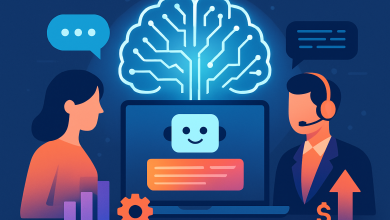In today’s AI-driven world, marketing isn’t just about getting louder—it’s about getting smarter. More ads, more posts, and more pixels won’t necessarily drive growth if you don’t understand what your customers really want.
The truth is, your most powerful marketing insights are probably not in your Google Analytics dashboard or buried in your Facebook ad manager—they’re in your phone calls.
That’s right. The conversations your customers are having with your team are marketing goldmines—and AI call monitoring is the tool that lets you dig them up at scale.
Let’s break down how AI call monitoring is transforming marketing strategies—and how you can use it to sharpen your message, improve conversions, and build real customer loyalty.
What Is AI Call Monitoring?
Traditional call monitoring was a slow, manual process. Managers would randomly listen to sales or support calls to check for quality assurance or coaching opportunities. But realistically, reviewing more than a handful of calls per day was unscalable and inconsistent.
AI has changed everything.
Today, advanced call monitoring tools powered by artificial intelligence don’t just record conversations—they analyze them in real time. Using speech recognition, natural language processing (NLP), and sentiment analysis, these tools can transcribe conversations, detect emotions, highlight keywords, and surface patterns across thousands of calls.
Think of it like having a 24/7 marketing analyst who listens to every customer conversation, understands their tone and intent, and delivers insights instantly.
Why AI Call Monitoring Matters for Marketing
When customers pick up the phone, they reveal things they don’t type in forms or comment online. Real opinions. Real pain points. Real language.
AI helps marketers capture that goldmine of data and translate it into campaigns that actually convert via AI powered analytics for marketing.
Here’s what it unlocks:
- Customer intent, decoded: AI picks up on repeated phrases, emotional triggers, and trending questions—so you know exactly what your audience wants, fears, or misunderstands.
- Live feedback loops: Spot friction points in real time. If callers sound confused about a feature or annoyed about pricing, your team can adjust messaging before it spreads.
- No more guesswork: AI reveals the actual language customers use—perfect for optimizing ad copy, website content, and emails.
Real-World Example: Insights in Action
Let’s say you run an eCommerce business selling home gym equipment. Your marketing team has been running ads with messaging like:
“Compact. Sleek. Space-Saving Design.”
But AI call monitoring reveals something different. A large percentage of callers are asking:
- “Is this durable?”
- “Can it support heavy weights?”
- “What’s the lifespan of the product?”
That’s a clear gap between what you’re marketing and what your customers are actually concerned about.
With that insight, you shift your messaging to:
“Built to Last. Trusted by Serious Lifters.”
Or even:
“Engineered for Durability: Your Home Gym Partner for Years.”
The result? Higher ad engagement, better conversion rates, and messaging that finally matches the conversation happening in your customers’ heads.
How to Set Up AI Call Monitoring in Your Marketing Stack
You don’t need a massive tech team or enterprise budget to get started. Follow these steps:
- Choose an AI-Enabled Call Analytics Tool
Look for platforms like CallRail, Invoca, Observe.AI, or Gong. These tools offer features like:
- Automatic transcription
- Emotion/sentiment detection
- Keyword flagging
- Intent and topic tagging
Make sure it integrates well with your current systems.
- Set Up Keyword and Sentiment Alerts
Create alerts around specific words or phrases like:
- “Too expensive”
- “Didn’t understand”
- “Love the product”
- Competitor names
Also monitor sentiment shifts—frustration, confusion, or satisfaction—so you can dig deeper.
- Integrate with Your CRM and Ad Platforms
Push insights directly into your CRM (like HubSpot, Salesforce, or GoHighLevel). Use them to:
- Automatically tag contacts based on interest or objection type
- Trigger retargeting campaigns
- Segment audiences more effectively
- Refine Your Buyer Personas
Combine AI-derived call insights with your existing customer data to build more accurate, real-world personas. Go beyond demographics—dig into desires, objections, and fears.
What You’ll Gain from AI Call Monitoring
Businesses that embrace this technology often see:
- 🔥 Ad copy that actually converts—by using the language your audience already trusts
- 📧 More effective emails—because subject lines and copy are based on real feedback
- 🎯 Better targeting—driven by authentic voice-of-customer data
- 🧪 Faster A/B testing—as feedback loops help you test messaging more efficiently
- ❤️ Stronger relationships—by solving problems before they become complaints
FAQs: AI Call Monitoring for Marketing
Q: Is AI call monitoring only for large enterprises?
Not at all. Many tools have small-business pricing plans. Even tracking 50-100 calls per month can provide massive insight.
Q: Will my team need training?
Minimal. Most tools offer visual dashboards and simple interfaces. Your marketing team just needs to know what they’re listening for.
Q: Is this GDPR/CCPA compliant?
Most AI tools are built with compliance in mind, but always ensure your customers are informed that calls may be recorded or analyzed.
Final Thoughts: Listen Smarter, Market Smarter
AI call monitoring flips traditional marketing on its head. Instead of guessing what works, you know. You’re not relying on second-hand analytics—you’re getting insights straight from your customer’s voice.
Every call becomes a data point. Every conversation is an opportunity to refine, optimize, and connect. And because AI does the heavy lifting, your team can focus on the creative strategy that drives real results.
So stop guessing. Start listening. That’s the future of smart marketing.




